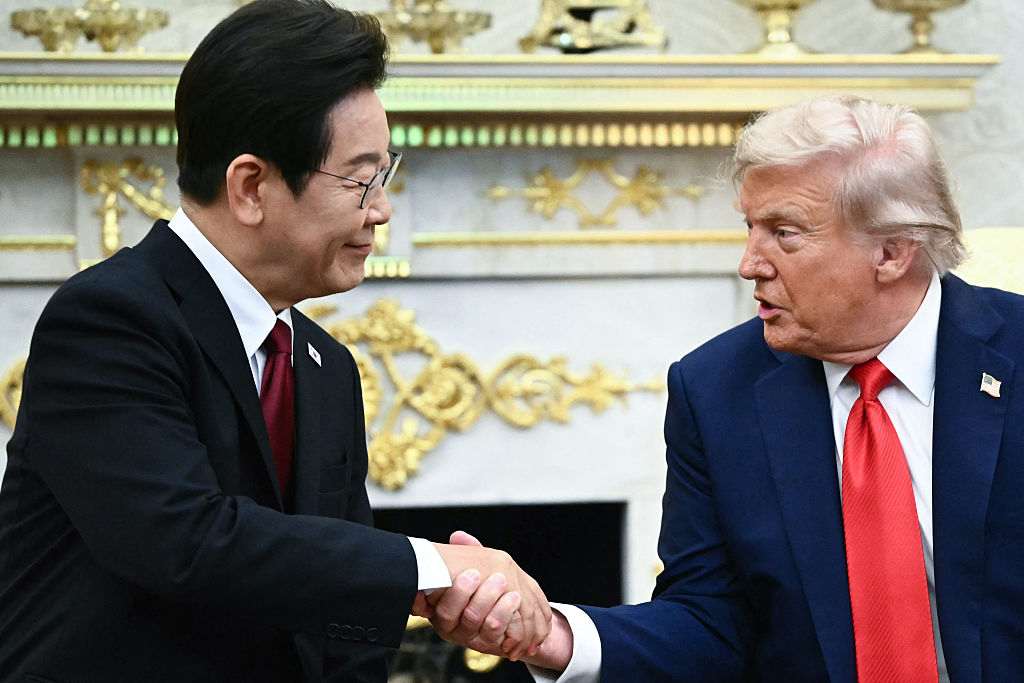
But the details over Seoul’s investment proposal will matter quite a bit.
President Trump met with his South Korean counterpart, Lee Jae Myung, at the White House on Monday to iron out the details of the trade deal the two countries struck in July.
One big remaining wrinkle? Shipbuilding.
“We’re thinking about contracting some ships,” Trump said in the Oval Office following their meeting. “They build them very well in South Korea. They’re also thinking about coming to our country with some shipyards to start us on the process of building ships again.”
South Korea indeed has a healthy shipbuilding industry – the world’s second largest after China – and its negotiators have dangled their industrial know-how as part of a proposed $150 billion investment in the U.S. shipbuilding sector to secure more favorable terms in their negotiations over Trump’s reciprocal tariffs. The last time they were in Washington, they brought custom-made red “Made America Shipbuilding Great Again” baseball hats. One of their delegation’s leaders said the “project contributed most significantly” to the tariff agreement that brought the rate for South Korean exports to the United States from 25% down to 15%.
And, as if to underscore the effort his government is putting behind this pitch, President Lee is set to visit Philly Shipyard on Tuesday, a major shipbuilding industrial site purchased by a South Korean company for $100 million just last year.
The details of that $150 billion proposal, however, will be very important and the summit raises new questions about why Trump said the U.S. would be buying ships directly from South Korea rather than making them ourselves. We’ll be watching to see if the White House clarifies this off-handed remark or if it truly intends to outsource U.S. shipbuilding to South Korean shipyards.
South Korea didn’t just pluck shipbuilding as an avenue for negotiation out of the air. It was done amid heightened concerns in the United States about the state of our own commercial shipbuilding industry, which has declined significantly in recent decades for various reasons – not the least of which is China’s whole-of-government effort to dominate the sector globally. The number of U.S. yards capable of producing or repairing large oceangoing vessels like cargo ships and tankers has gone from 27 to eight; the industry has shed more than 70,000 jobs; and more than 20,000 suppliers have exited the market, leaving our domestic supply chain vulnerable. The United States has, regrettably, turned to foreign entities for various maritime infrastructure needs, including ship repair and maintenance.
China’s shipbuilding industry, meanwhile, has grown larger and more dominant by the year. It’s heavily state-owned, deeply subsidized, and built on the back of industrial espionage and discriminatory trade practices. A leaked Navy document estimates China’s shipbuilding capacity is 232 greater than our own.
Shipbuilding is a national security issue because maintaining a navy requires a healthy shipbuilding industrial base. And that’s saying nothing of the obvious economic benefits that would accrue if more shipbuilding activity was done at home.
It’s critical that the United States reverse these trends, and any delays or self-imposed errors in doing so would be problematic.
That’s why last year a coalition of labor unions petitioned the federal government to investigate the hurdles that China’s shipbuilding dominance present to any attempt at reviving our own industry. That investigation affirmed the unfair practices that were alleged, and the Trump administration has continued the process by proposing responsive actions that will take effect later this year. Starting in October, Chinese-built vessels visiting U.S. ports will be assessed fees – serving to disincentivize shippers from buying ships from China.
It’s why there’s a bipartisan bill in Congress that would direct these fees into investments in U.S. shipyards, workers, and other maritime infrastructure.
It’s also why a South Korean investment in the U.S. shipbuilding industry could be welcomed. But it must mean investment in the United States, so that we’re modernizing existing shipyards and building new ones, and ultimately launching more U.S.-made ships. This is work that should not be outsourced to South Korean shipyards, even in the short term.
We must be able to build, maintain, and repair the vessels that keep commerce moving and our nation secure. Continuing to rely on foreign governments or overseas facilities will only put the opportunity to do that further out of reach.
